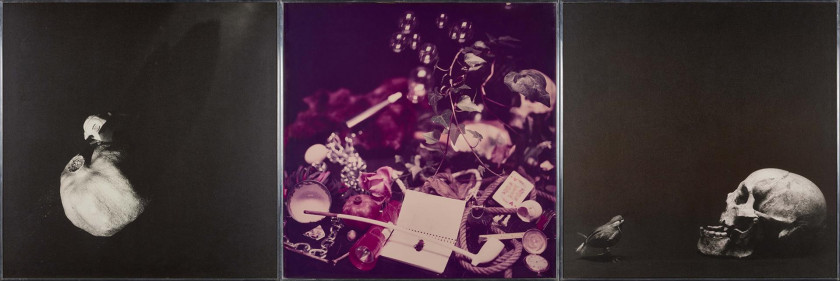Noses & Ears, etc.: Spears And Two Torsos (With Noses)
photography
![Noses & Ears, Etc.: Spears and Two Torsos (With Noses) [Narizes & Orelhas, Etc .: Lanças e Dois Torsos (Com Narizes)]](https://cms.macam.pt/storage/uploads/thumbs/inarte-work-3071_w840.jpg)
![Noses & Ears, Etc.: Spears and Two Torsos (With Noses) [Narizes & Orelhas, Etc .: Lanças e Dois Torsos (Com Narizes)]](https://cms.macam.pt/storage/uploads/thumbs/inarte-work-3071_w840.jpg)
2006
Three-dimensional image, archival digital photographic print with acrylic paint
109,7 x 165,2 cm
John Baldessari (1931-2020) is widely recognised as one of the most influential American artists of the second half of the 20th century. Alongside his academic career (a profession he pursued until the early 2000s at various Californian institutions), his artistic practice constantly revisits and questions art history—particularly in terms of the contrast between a sharply critical understanding of European tradition and a new American conceptual language. Renouncing what had been a body of work determined by his predisposition for painting (which he burned), in the early 1970s Baldessari began a new way of working characterised by the use of photographic images. Collecting and cataloguing references very particular to American aesthetics, images of an advertising and cinematographic nature began to make up a vast visual archive that would be used by the artist as a surface for manipulation. Sometimes textual, sometimes pictorial (often both), these interventions constitute the dizzying emergence of an authorial language clearly permeated by a very particular patina of irony and semiotic provocation. Driven by a fascination with deconstructing the conventional perception of the planes of an image, as well as the surface that supports it, the series Noses & Ears, Etc. presents itself as the natural result of an oeuvre that always sought to enhance the internal relationship between painting, photography, and sculpture (the works being characterised by their simultaneous pictorial and sculptural inscription on the photographic surface). Recalling one of the most iconic mottos in his work—the conceptual relevance of choices of omission and unveiling—the artist assigns to faces, or more specifically to faces stripped of portraiture elements, the place of strange familiarity so characteristic of his work. With the isolation of noses and ears in these images, Baldessari nullifies and subverts the details of human features that, according to historical consensus, are privileged for their capacity for isolation (as in Man Ray, Odilon Redon, or Luis Buñuel, for example), violently reducing the referent's capacity for identification.
Eva Mendes
